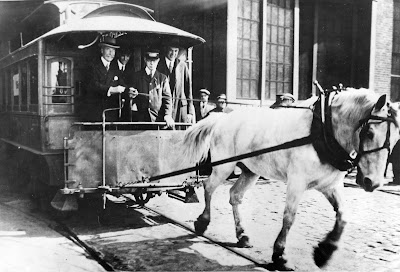 |
| Competitors in Schenectady's Soap Box Derby in the late 1940s on Fehr Avenue near Central Park. Winners of the local Soap Box Derby then went on the compete at the All-American Soap Box Derby at Derby headquarters in Akron, Ohio. Photo from Larry Hart Collection. |
"All boys of Schenectady and its immediate vicinity who like excitement, adventure, racing - front and center," read the opening sentence of a
Schenectady Gazette article encouraging local boys to sign up for Schenectady's first-ever Soap Box Derby in 1937. Sign up they did; the late 1930s, late 1940s, and early 1950s saw scores of local boys compete annually.
 |
| 13-year-old Richard Vandercar constructs his soap box racer in the basement of his Elbert Street home in this June 25, 1946 Schenectady Gazette photo. Image obtained via www.fultonhistory.com. |
America's first official Soap Box Derby was held only three years before the first Derby in Schenectady. The idea for the national Derby had come from reporter Myron Scott of Dayton, Ohio, who conceived of a competition after he saw some boys racing in homemade vehicles in 1933. Chevrolet soon stepped up as corporate sponsor for the event, and the first All-American Soap Box Derby was held in Dayton in 1934. The national race moved to Akron, Ohio, the following year and has remained there ever since. The competition was open to boys from ages 11-15. Boys had to make their racer without adult assistance, and their racer had to be equipped with steering wheels and brakes. Local youths used discarded scraps, wooden crates, and other found materials to construct their cars. The winners of local races in approximately 120 American cities would travel on to Akron to compete in the All-American Soap Box Derby.
 |
| Racers line up as spectators gather on Fehr Avenue. 87 boys competed in this 1947 race. Photo from Larry Hart Collection. |
The first Soap Box Derby in Schenectady was held on July 24, 1937, on Fehr Avenue off of State Street. The Derby was preceded by a parade of the entrants and Derby officials. In total, 175 local boys entered the race, which was sponsored an promoted by the Schenectady Gazette and local Chevrolet dealerships. Boys competed in two classes - one class for 11- and 12-year-olds and one class for 13-to-15-year-olds. The winner, 15-year-old Waldron Stemm of Scotia, was sent to represent Schenectady in the national competition and earned a gold medal, a trophy, and additional prizes from local businesses. Additionally, prizes were awarded for the best designed car,the best upholstered car, the best designed set of brakes, and the first boy to construct his racer. Each entrant was given a regulation steel racing helmet, and a number of local businesses and organizations, such as the Apex Store, Barney's, Carl Company, Reinhard's Cycle Shop, Goldstock's, White Studios, and the YMCA offered prizes. Schenectady's civic leaders called the Derby a resounding success. "Despite the fact that Saturday's derby was the first of that nature ever conducted in this section," wrote the
Schenectady Gazette, "many fine miniature cars were constructed. Next year the youngsters will be familiar enough with the derby idea to iron out many of the construction wrinkles with the result that competition should be on a much higher plane." Soap Box Derbies continued in Schenectady through 1940. The competition was suspended from 1941 through 1945 (the national competition was also halted for the years 1942-1945); it was resumed in 1946.
 |
| Nancy Adams presents the first-prize trophy to 1946 Schenectady Soap Box Derby winner Paul Supley. All participants in the race received a racing helmet and a Schenectady Gazette Soap Box Derby t-shirt. Photo from August 5, 1946 Schenectady Gazette; image obtained via www.fultonhistory.com. |
When the competition resumed in 1946, it came back with a bang. WRGB televised the races, which were also featured on local radio. 1946 was also the only year that the competition was held on Gerling Street, between Lenox Road and Golf Avenue, rather than on Fehr Avenue. Advertisements in the Schenectady Gazette featured sponsorships of specific racers by local businesses -- in 1948, the Town Tavern endorsed "JoJo" Niedhammer, while the Sealtest General Ice Cream Corp. championed Robert Bayer and Richard Kelly and the Sears store on Erie Boulevard expressed confidence that either Sid Della Ratta or Albert Madonna would take home the gold. The Derby continued in Schenectady through 1951; the next year, the location of the regional contest was moved to Albany before shutting down in 1954. The Albany Soap Box Derby was resumed in the early 1960s and continued until the early 1970s. The Soap Box Derby also had a brief revival in Schenectady, holding races at Mohawk Mall for a few years before returning to the Fehr Avenue site in 1976. 1976 was the last year of the Soap Box Derby in Schenectady; the race that year was also won by a girl, 12-year-old Christine DuBrey of Schenectady. Girls were allowed to compete at the national level beginning in 1971. Today, the region's races now occur under the auspices of the Capital District Soap Box Derby, with annual races being held on Madison Avenue in Albany.
 |
| Spectators look on as racers prepare to compete in the 1947 Schenectady Soap Box Derby. Photo from Larry Hart Collection. |
 |
| This advertisement for the 1940 Schenectady Soap Box Derby appeared in the Schenectady Gazette on June 18, 1940. Image obtained via www.fultonhistory.com. |



























